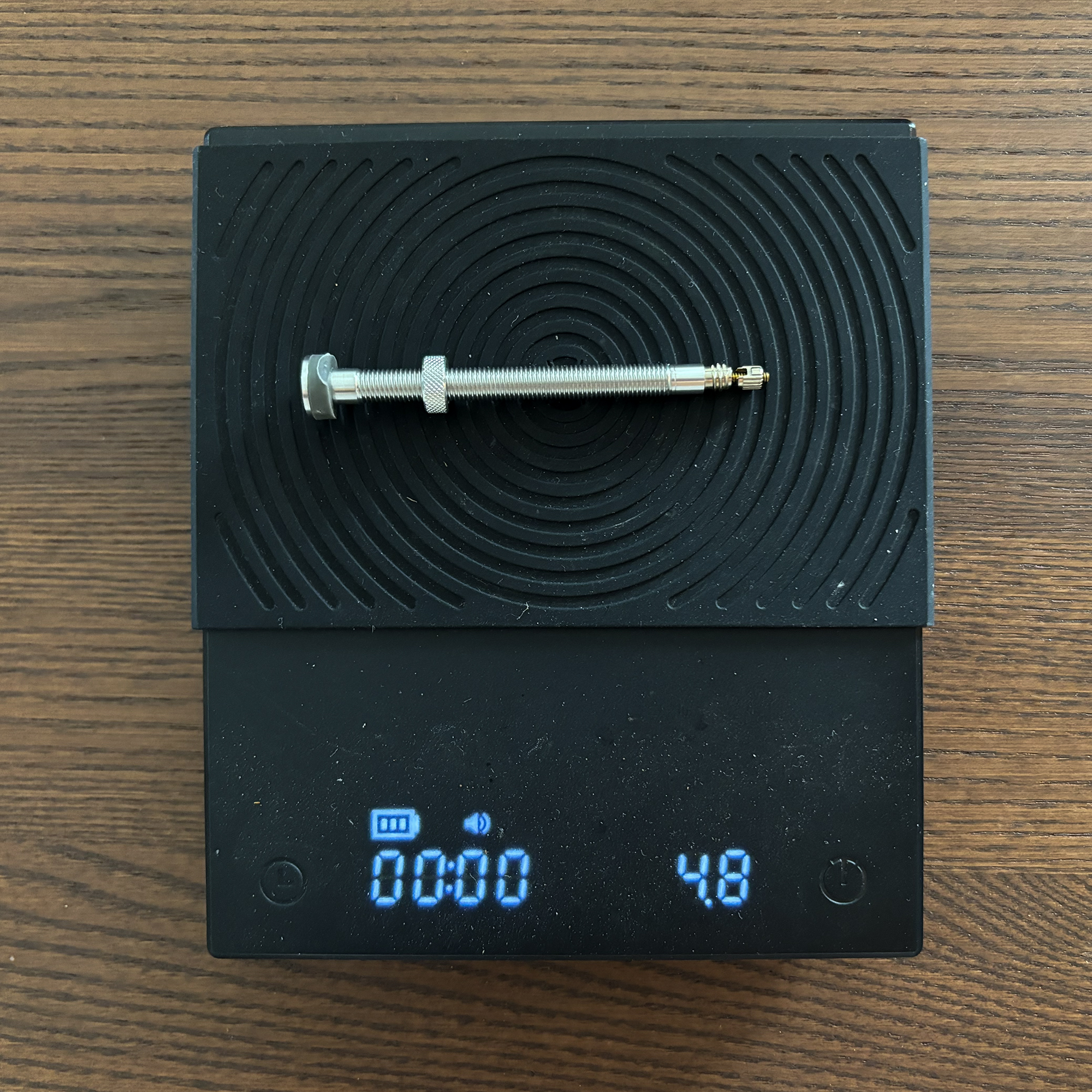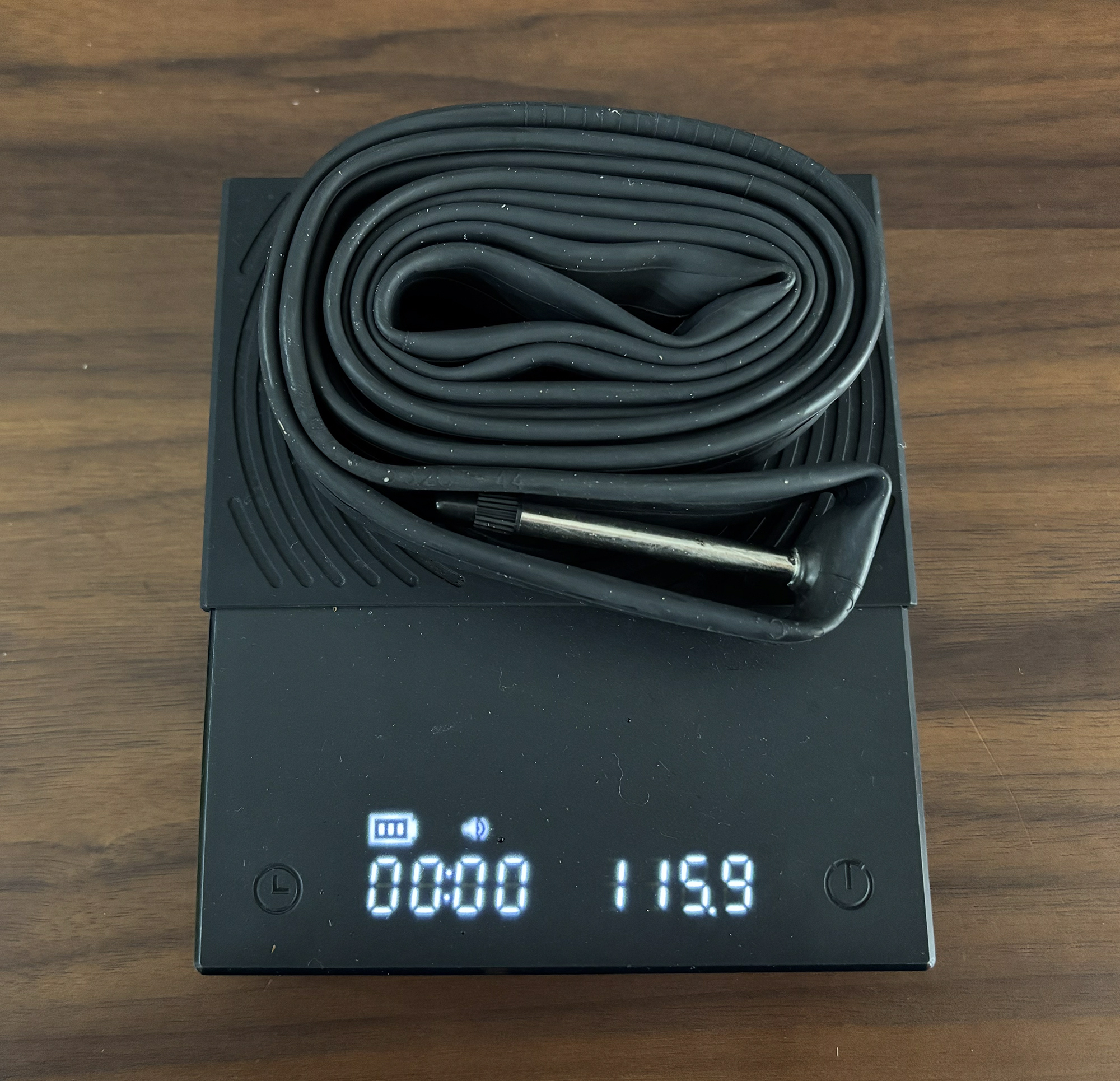In my previous article, I introduced (what I thought back then would be) the best way to save some weight off your bike - tyres.
If you haven’t read it yet, here’s the link.
In many ways, compared to upgrading other components on your bike, choosing the right tyre is inexpensive, lightweight, and improves the ride quality; that’s why I titled it “the best” way to save weight.
Except it isn’t.
Because there is a much better bang-for-your-buck upgrade choice for the ultimate weight-saving: inner tubes.
Tubes V.S. Tubeless
To save some weight from inner tubes, you have to have tubes in the first place.
So, there is no getting around the tubes V.S. tubeless debate. Nowadays, more and more pro pelotons in world tours are going tubeless, and many technically inclined enthusiasts also made the switch, especially in the MTB area. Here we won’t talk about the pros and cons of tubeless (that might be worth a whole article by itself), but only the weight-saving part:
At first glance, tubeless sounds lighter: it’s already in the names. Tubeless means there is no tube at all, hence cutting some weight down by removing the inner tubes.
But is it really lighter?
Short answer: No.
Why is Tubeless Heavier
Extra Materials and Different Casing Structures
To support the load all by the tyres themselves without the help of inner tubes, tubeless tyres must use different structures and extra materials, making them heavier than their clincher/tube-only counterparts.
All other conditions equal, tubeless tyres alone can easily be 80 grams or so heavier than clinchers, each tyre.
For example, Vittoria’s Corsa N.ext model provides both tube-type and tubeless-ready options. At 700x28c:
- Corsa N.EXT Tube-Type: 210 grams
- Corsa N.EXT Tubeless-ready: 300 grams
There is a whole 90-gram difference in just one tyre, which is already more than most lightweight butyl inner tubes, not to mention latex and TPU tubes (more on this later).
Sealant and Tubeless Valves
For puncture resistance, tubeless tyres require some amount of liquid sealant injected into the tyres. As a rule of thumb, for a 700x28c tyre, you normally need around 60 ml sealant, which is about 60 grams even if the density is at 1 g/ml. In reality, 60ml sealant probably weighs more than just 60 grams. For example, I found a discussion here on Reddit that the dried sealant weighs 5 grams.
And, tubeless setup requires tubeless valves, which adds some extra weight. I’m not saying it’s a lot, but even made from lightweight materials, they still would add a few grams:
To sum up: Don’t go tubeless if your sole aim is to cut some weight.
Since tubeless isn’t the way to go for weight-saving, let’s look at some (lightweight) inner tubes.
Materials of Inner Tubes
In general, there are currently three types of materials available:
- butyl
- latex
- Thermoplastic Polyurethane (TPU)
In short:
- Butyl is probably the most used material for inner tubes. Most of those standard, heavy, black, and ugly inner tubes we see are made of butyl. It has been around for a long time, it’s cheap but heavy. There are some lightweight (relatively) options, though.
- Latex: colourful, mostly in pink. Significantly lighter than butyl, more expensive, has less friction against the tyre hence lower rolling resistance, and leaks air more quickly than butyl.
- TPU: the new kid on the block. Lightest, can be very expensive (depending on the brand) but there are also cheaper options, with slightly more rolling resistance than latex but less than butyl.
For a much more comprehensive guide on these three inner tube materials, watch the video from GCN.
For lab-tested rolling resistance, see the bicycle rolling resistance test result. TL;DR: the difference isn’t huge, only single digits in terms of watts, not something we can actually feel.
So, rationally, we should not put rolling resistance on the top of our priorities list based on which the choice of inner tubes shall be made.
Butyl
The weight of butyl inner tubes may differ, by quite a big margin, as we shall now demonstrate:
This is an inner tube that comes in stock with my Specialized road bike, it’s relatively lightweight for a 700x18–25c model. Decent weight at 80+ grams, I’d say. Although marked as 18–25c, I have used it in 700x26c/28c tyres for over 8000 km in a year without any problem.
If going for cheaper options, for example, the base model from Decathlon above, for the same spec (more or less, max 28c), it adds 30 grams of weight.
However, heavier butyl tyres aren’t all bad:
- Heavy tubes are cheaper. The Decathlon above is 1/2 or even less than the previous lightweight Specialized.
- Heavy tubes are thicker, meaning more puncture-resistant, making them ideal for winter rides or where the road condition is suboptimal.
The one above is another lightweight butyl tube from Maxxis. It’s the ultralight model, 700x23–32c with a 60mm valve, shredding 10 grams off the Specialized inner tube at 1/2 of the price.
I used it for a few thousand kilometres with only one snake bite puncture (mostly because the tyre pressure isn’t set up correctly, not the tyre’s fault). I can personally recommend it for daily use where road conditions aren’t too bad, OK on worn tarmac with a few cracks.
This is basically as light as it can go for lightweight butyl tubes when price is also a consideration. For sure, there are 55–60g ultra lightweight butyl tubes out there if you are willing to pay for the premium. But if you are willing to pay (a lot) extra, maybe you have better choices. Read on.
Finally, we have this big boy: Specialized Turbo 700x28–42c pre-talc’d 48mm valve for gravel bikes. The weight increases significantly compared to 18–28c road tubes, even though this is already a lightweight model for this size according to Specialized 40 grams lighter than other options.
So, if you ride a gravel bike or go wide on your road bike, butyl inner tubes can weigh significantly more. As a rule of thumb, upgrade your butyl inner tubes to other lightweight materials if you ride a gravel bike. Because in this case, you can save more weight, making it especially worth it.
Next, let’s continue with the lightweight materials.
TPU
TPU tubes can be significantly lighter:
Above is a 700x18–32c TPU with an 85mm valve made by a brand called Ride Now. It’s advertised at 36 grams, which is quite accurate.
Note that this isn’t even the lightest model for an 18–32c TPU tube; you can go as low as 2x grams.
I’ve been putting a thousand kilometres on it, and I can say that compared to butyl, I can’t feel any difference in terms of feeling, rolling resistance, performance, puncture resistance or leakage. Maybe there are some differences, but they are so few that people with not-so-sensitive nerves like me cannot tell. The only time I can feel the difference is when I put it on a scale.
So, it’s lightweight and there seems to be no downside. What’s the catch?
Price. TPU tubes used to be expensive. It was normal to see them in the $25–30 range, for example, some models from Tubolito.
But thanks to Alibaba and Chinese manufacturers, they are becoming more and more acceptable now, even below $10, no more than double the price of a lightweight butyl, making it a no-brainer: Why get butyl when you can get a TPU at basically the same price range which is significantly lighter and you probably can’t tell the difference except the weight?
Latex
I don’t have much experience with Latex tubes, mainly because I think the weight sits somewhere in the middle between TPU and butyl, while the drawbacks for me are obvious:
- leaks air quicker, which means more operational overhead
- price
Borrowing a picture from Bike Radar to make my point:
Of course, as aforementioned, the upside is low rolling resistance, but it’s so minor that we cannot actually feel it. For me, I’m an extreme guy: either go for butyl for the cheaper cost or go for the lightest. That’s why I gave it up.
Summary
Most people probably still stick with butyl, but with the price coming down, it’s harder to see a benefit now.
Maybe some are used to butyl and don’t want to change, maybe some had unpleasant experiences with TPU and don’t want to give it another chance, maybe…
For me, lightweight TPU tubes at a reasonable price are a no-brainer. Even considering some expensive TPU brands, it’s still well worth the money if you calculate the dollar-per-gram ratio. It’s probably the most worthy part to cut down weight.

With the help of TPU, I managed to upgrade from lightweight wheels to deep sections (33mm -> 51/60mm) with a weight penalty of merely 75 grams. Impressive, right? I know.
FAQ
Based on my experiences, there are a couple of take-away points (at least for myself) and I’ve organized them in the format of an FAQ:
Q: If I have to choose butyl for some reason, shall I go for the standard butyl or a lightweight model?
A: Lightweight.
Prices of butyl tubes are much more acceptable compared to latex/TPU, meaning that going for the lightweight model doesn’t hurt your pocket at all but you can easily save 40 grams, per wheel.
There is one exception, though: if you ride in winter, or relatively bad road conditions and want more puncture resistance, the even cheaper, heavier non-lightweight butyl tubes are a wise choice.
Should I Change Butyl to TPU?
If you are riding a gravel bike with chunky tyres and tubes, in general, the answer is yes, because you get extra weight savings compared to narrow road bike tubes, making it more worth it.
If you are riding narrower tyres, it depends.
Is TPU’s weight saving worth the money?
Short answer, and surprisingly: No.
If you have to ask, the answer is no.
If you are racing, carrying a few grams less up a hilly course can mean the difference between trophies or not.
On the other hand, if you are not riding competitively, even a hundred grams of weight saving doesn’t matter much: We all know that aerodynamics matters more than weight even at lower speed at some gradient, so saving 100 grams on a 20km 5% climb for a few seconds, when you are not racing, is simply not worth it.
But things get trickier when the price of TPU gets lower, some even come close to lightweight butyl tubes.
In my opinion, if you can get your hands on some quality TPU tubes at a reasonable price, there is basically no reason to stick to butyls any more. For me, I managed to find Maxxis lightweight butyl at $4.55 and Chinese branded TPU at $5.25 with a weight difference of 40 grams, I can’t find any reason not to switch to TPU.
However, if you buy lightweight butyl at $5 and TPU at $25, it’s a whole different choice.
If you enjoy this article, please like, comment, and subscribe! Your support is the pedalling force that drives me forward.







